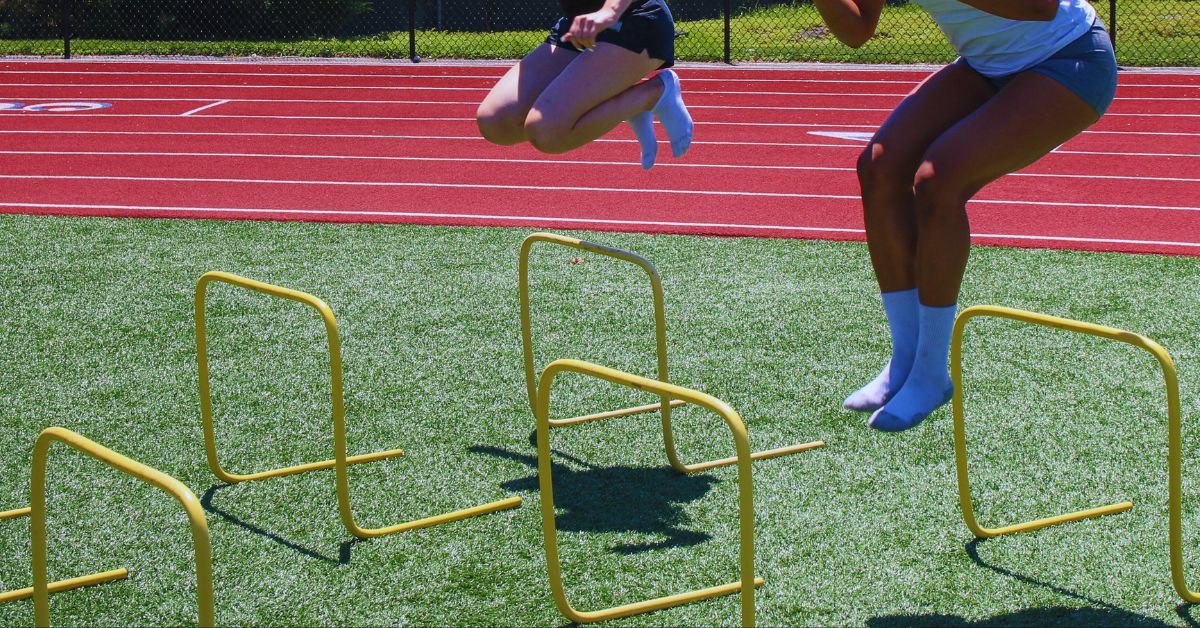
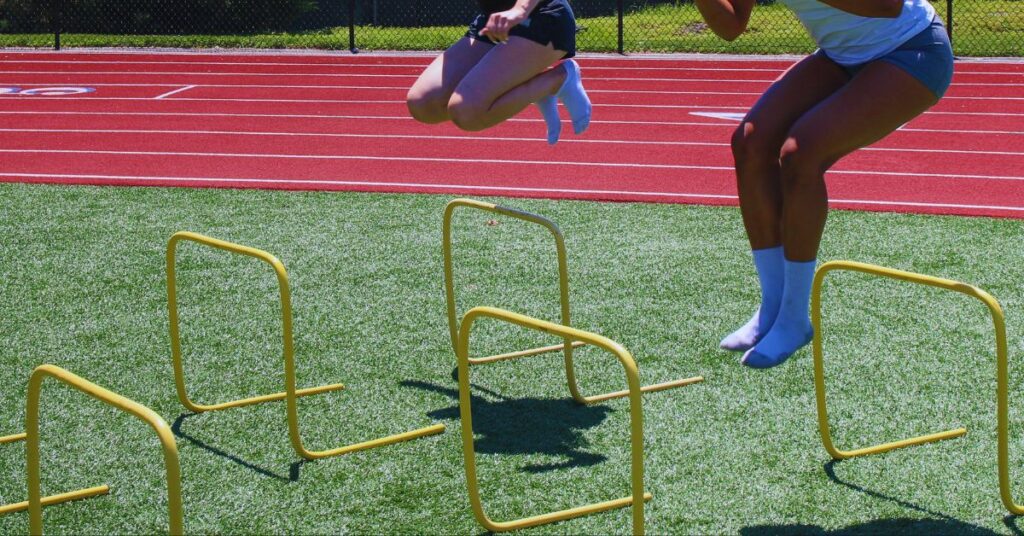
On this planet of power and conditioning, athletes typically carry out a whole lot and even 1000’s of jump-based workouts or actions all through their annual coaching cycle as a method to develop explosive energy and athletic efficiency. For these athletes, leaping is simply a part of the equation; touchdown safely from every soar in a fashion that minimizes danger of knee damage bears immeasurable significance.
Whereas power and conditioning coaches typically spend a lot of their time instructing their athletes on the mechanics of maximizing soar efficiency and explosive energy (and rightfully so), not as a lot instruction or time is usually given in the direction of touchdown safely or effectively.
That is problematic since poor touchdown mechanics can considerably improve damage potential to the athlete, notably to the knee. Over 25% of all athletes who expertise an ACL tear is not going to return to their earlier exercise ranges even with profitable surgical procedure and rehabilitation, and athletes who endure ACL reconstruction are 15 occasions extra more likely to re-rupture than these with out historical past of ACL rupture.1,2
Over 25% of all athletes who experience an ACL tear will not return to their previous activity levels even with successful surgery and rehabilitation. Click To Tweet
Whereas coaching for maximal leaping potential is important to optimizing an athlete’s efficiency, optimum vertical soar efficiency doesn’t imply a lot if an athlete sustains an damage upon touchdown. As such, optimum biomechanics when touchdown from a soar process are simply as important to develop as when executing the soar itself.
Why Take a look at Bounce Touchdown Mechanics?
Whereas contact-based knee accidents inside sport are primarily non-preventable, non-contact knee accidents must be of explicit curiosity to power coaches and clinicians because of the largely modifiable neuromuscular elements that may be carried out to cut back or remove their prevalence.3
Non-contact knee accidents are prevalent inside sport, with roughly 18% of those accidents arising inside sport play and 37% arising inside apply or coaching classes.4 Biomechanical errors involving knee valgus and stiff landings, amongst different such faults, are related to elevated damage danger to the athlete.
Whereas quite a few motion screening protocols have been designed to determine potential damage dangers and aberrant motion patterns, many of those screens don’t analyze an athlete’s jump-landing mechanics—an integral sport-specific process for a lot of athletes. This isn’t to say that different screening protocols must be discouraged; fairly that the coach or clinician should account for all aspects of the athlete’s sport and implement motion screening protocols consistent with their sporting duties, together with touchdown from a vertical soar.
The coach or clinician must account for all facets of the athlete’s sport and implement movement screening protocols in line with their sporting tasks. Click To Tweet
For instance, Everard et al. performed a analysis examine to determine the connection between the Useful Motion Display screen (FMS) and the Touchdown Error Scoring System (LESS). Whereas each programs have been proven in quite a few research to be dependable and legitimate, the outcomes from Everard et al. discovered that performing properly on one display didn’t point out an athlete would carry out properly on the opposite.5
As such, screening for, and revealing, biomechanical flaws inside an athlete’s motion ought to embrace each generalized motion patterns in addition to sporting-specific duties to maximise the athlete’s total security and wellbeing. Within the case of athletes whose sporting duties contain leaping (basketball, volleyball, and so on.), making certain optimum biomechanics when touchdown shouldn’t be missed.
How any recognized biomechanical points are corrected will rely on a number of elements, together with the actual faults recognized, wants of the athlete, and scope of apply for the coach or clinician. As such, it is very important understand that there isn’t any common strategy for the way soar touchdown mechanics must be rectified.
Consequently, the next is a dialogue of the Touchdown Error Scoring System because it pertains to screening for non-contact knee damage dangers in athletes, but it surely doesn’t provide particular perception concerning corrective intervention. An individualized strategy ought to all the time be taken for every athlete.
The LESS Check
The LESS is a screening instrument developed to determine the danger of potential non-contact knee damage in athletes, notably for ACL damage (although related danger akin to meniscal and MCL accidents may also be factored). The premise of the system is that identification of biomechanical (physique position-based) errors current throughout the decrease extremities throughout jump-landing can result in discount of damage danger by way of corrective interventions, akin to hip and knee strengthening, enhancing proprioceptive consciousness, and total touchdown approach.
The premise of LESS is that identification of biomechanical errors present within the lower extremities during jump-landing can lead to reduction of injury risk via corrective interventions. Click To Tweet
The jump-landing process is recorded by way of video from two completely different cameras—one recording the sagittal aircraft (recording the athlete from the aspect) whereas the opposite information the frontal aircraft (recording the athlete from the entrance). Every digicam is positioned 3 meters away from the touchdown zone at a peak of 1 meter above the ground.
The system works by evaluating 17 completely different biomechanical occurrences that happen all through the physique in the course of the jump-landing process (additionally termed a drop-vertical soar). The examination for scoring could be divided into three classes:
- Bounce-landing approach because it pertains to place of the trunk and decrease extremity place upon connecting with the bottom.
- The scoring of faults involving foot place between preliminary floor contact and maximal knee flexion.
- Actions of the trunk and decrease extremities that happen between preliminary floor contact and maximal knee flexion.
Scoring for the 17 objects makes use of a dichotomous scoring rubric for the primary 15 objects (see the scoring sheet beneath), noting both the presence or absence of a motion error; a rating of 0 signifies an absence of error whereas 1 denotes the presence of an error. Merchandise 16 (joint displacement) and 17 (total impression) could be scored with three potential outcomes (see scoring record beneath). The evaluation and subsequent scoring are achieved manually by a skilled particular person upon analyzing the recorded video at a later time limit.
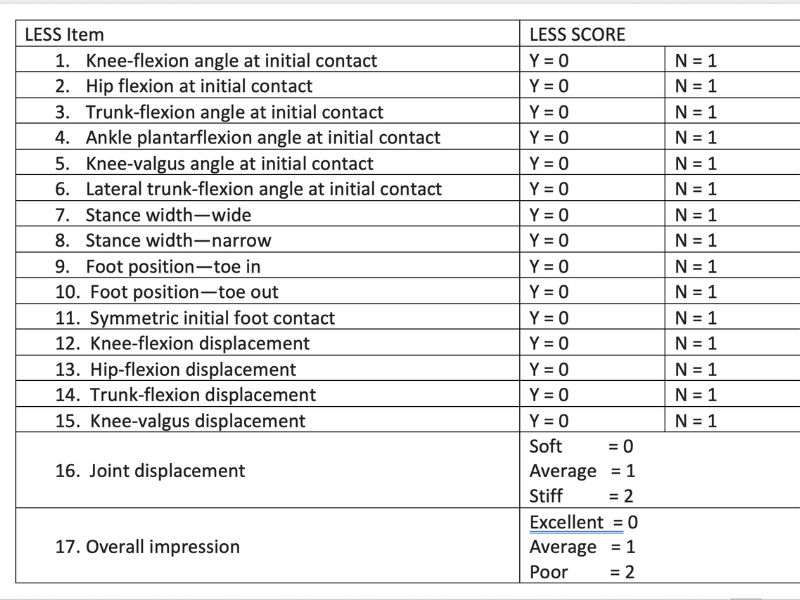
A better total rating of the check signifies a higher variety of motion errors arising in the course of the jump-landing process and due to this fact correlates with increased danger for potential non-contact knee damage for the athlete.
Testing Procedures
To carry out the check, the athlete stands on a 30-centimeter soar field. Then, when given verbal command, the athlete jumps ahead off the field with each toes, lands at a pre-measured distance of fifty% their physique peak in entrance of the field, and instantly performs a vertical soar with maximal effort.
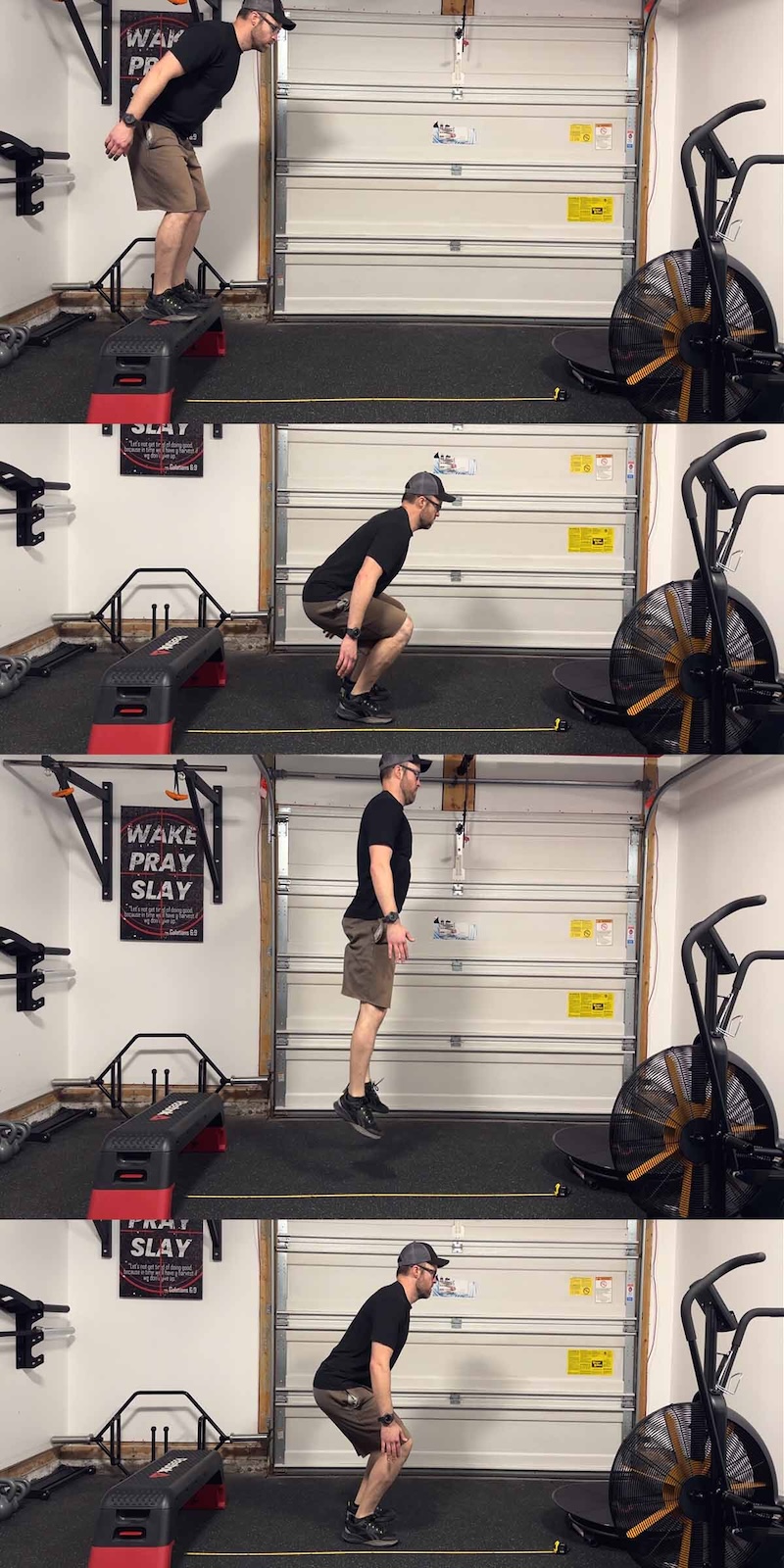
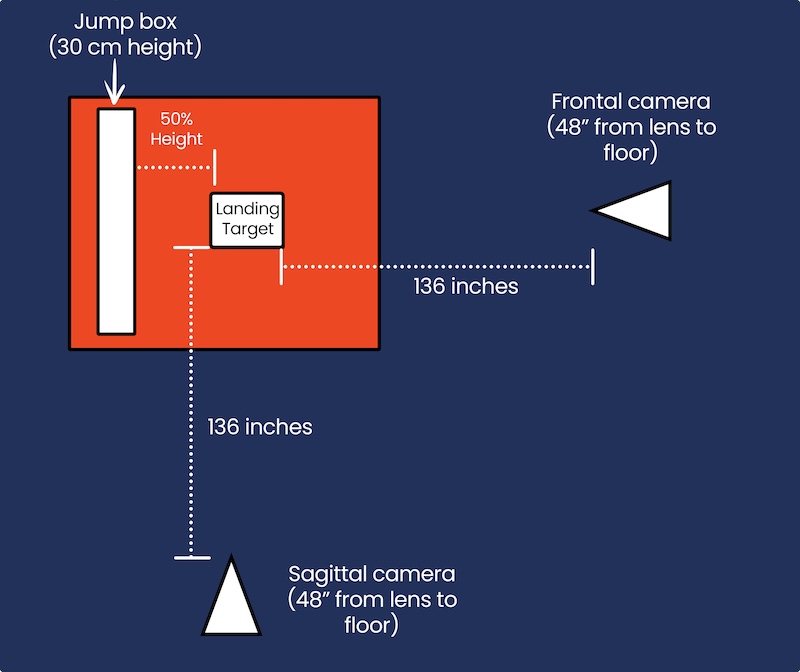
Validity and Reliability of the LESS Check
Any power coach or clinician incorporating standardized exams into their athletes’ testing—be it performance-based or prevention-based—ought to make sure the check is legitimate and dependable (validity assesses if the check measures what it claims to measure, and reliability assesses if the check is ready to constantly measure outcomes).
Any strength coach or clinician incorporating standardized tests into their athletes’ testing—be it performance-based or prevention-based—should ensure the test is valid and reliable. Click To Tweet
The LESS check has been proven to be each legitimate and dependable for the evaluation of jump-landing biomechanics because it pertains to damage danger inside athletes.6,7 The check additionally displays glorious professional vs novice interrater reliability when assessing 3D kinematic movement patterns utilized for scoring of the LESS.8
Strengths & Weaknesses of the LESS Check
As with every check or system, inherent strengths and weaknesses could be discovered throughout the LESS. The extent of every respective power and weak point will largely be decided by the coach or clinician concerning their very own distinctive conditions, assets, and so on.
Strengths of the Touchdown Error Scoring System
Naturally, the inherent power of the LESS is its repeated scientific-backing to be a legitimate and dependable screening instrument towards the danger of non-contact knee damage in athletes.6,9,10,11 One might argue that figuring out and stopping ACL and different related non-contact knee accidents by way of applicable intervention is the last word power of any screening system. Consequently, any inherent weaknesses of the system (mentioned beneath) could be seen as extra of an inconvenience, as damage prevention is value its weight in gold.
Of notable curiosity, the LESS has been proven to be legitimate and dependable for varied populations and has been proven to determine danger of re-injury in athletes having undergone ACL reconstruction, making it a noteworthy system for guiding areas of focus for the athlete’s rehabilitation and eventual return to sport.12 Moreover, throughout the ACL reconstruction inhabitants, the LESS has proven to disclose higher extent of touchdown errors for feminine populations when in comparison with their male counterparts.13
The LESS has been shown to be valid and reliable for various populations and has been shown to identify risk of re-injury in athletes having undergone ACL reconstruction. Click To Tweet
Limitations & Sensible Concerns
The requirement of devoted video tools to seize and thereafter analyze jump-landing mechanics in athletes has been seen as an obstacle by many clinicians and coaches, notably for organizations with a modest finances or for professionals who should document and thereafter manually analyze excessive volumes of athletes at a later time limit. Understandably, the necessity for a coach or clinician to accumulate video tools, set up a testing space, set-up tools, and watch recorded movies is commonly seen as a barrier to implementing LESS screening into athlete testing.
Moreover, when testing massive teams of athletes, the necessity to account for various touchdown positions with every athlete (touchdown distance is set by the athlete’s peak), can create a further inconvenience by transferring any visible touchdown goal for every athlete. Apparently, completely different touchdown distances are sometimes reported inside literature, although some authors have concluded that touchdown distance must be stored at a standardized distance of fifty% the athlete’s peak since completely different touchdown distances can produce completely different biomechanical outcomes, resulting in completely different scoring and subsequent categorization of errors.14
Actual-Time Evaluation: Modifications to the LESS
In an try to beat any perceived points involving practicality of the LESS, modifications to the system have been developed, permitting for real-time evaluation to be carried out both by an examiner or by way of devoted software program designed to seize, analyze, and interpret jump-landing mechanics in real-time.
Within the case of real-time scoring being carried out by a skilled coach or clinician, the modified LESS is used. For real-time evaluation and scoring carried out by devoted software program, the normal LESS is utilized.
The Modified LESS
With the modified LESS, a 10-characteristic jump-landing rubric is used rather than the normal 17-point rubric. This permits for simplification of the check so a skilled examiner can observe and rating the athlete’s efficiency in real-time, negating the necessity for video seize and later evaluation. The tester watches the athlete carry out two drop-jumps from the entrance and two extra from the aspect. All different metrics (field peak, soar distance, and so on.) stay the identical.
This modified model has been proven to have excessive ranges of interrater reliability, making it a sensible and dependable screening instrument for professionals working with the athlete.7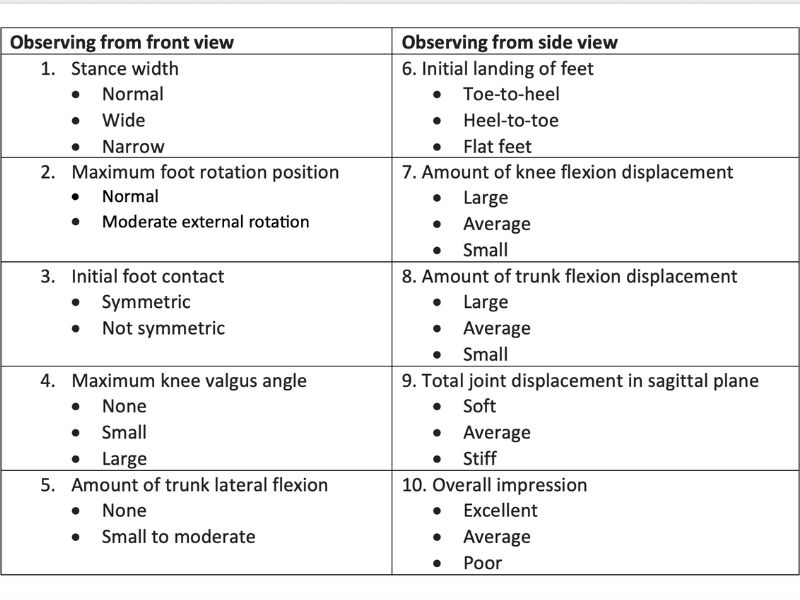
Computerized real-time evaluation
With the development of contemporary expertise, analysis has been undertaken to find out if computerized real-time video evaluation could be a legitimate and dependable means to performing the LESS evaluation. If the power exists for devoted software program to carry out such an instantaneous evaluation, the LESS might change into a way more environment friendly and sensible system to include for coaches and professionals working with groups and huge numbers of athletes.
With the advancement of modern technology, research has been undertaken to determine if computerized real-time video analysis can be a valid and reliable means to performing the LESS assessment. Click To Tweet
Presently, researchers have examined the power to automate conventional (i.e., non-modified scoring) LESS scoring by way of devoted software program and located doing so to be legitimate and dependable. One examine by Mauntel et al. discovered a real-time markerless movement seize software program to have the identical reliability in figuring out biomechanical errors as professional raters.15 When utilizing these explicit programs, it must be famous that completely different software program packages exist; nonetheless, many of those software program purposes depend on utilizing 3D movement evaluation or depth sensor cameras, which can nonetheless be value prohibitive for some coaches or organizations.
One other examine by Hébert-Losier et al. checked out automating the LESS by way of deep studying software program from 2D video when mixed with machine studying strategies, which eliminates the necessity for depth sensor cameras, permitting for evaluation by way of conventional video recording. Outcomes had been favorable, with the authors noting that deep studying software program will permit dependable scoring interpretation utilizing smartphone cameras and a subsequent app, paving the way in which to nice accessibility for coaches, groups, and clinicians trying to incorporate the LESS into their athlete assessments.16
It must be famous that the authors of this examine point out that additional examine of those software program programs and packages will likely be required to additional improve the scoring settlement between the automated system and handbook scoring achieved by coaches or clinicians past their present ranges.
Last ideas
If leaping is all about efficiency, touchdown is all about security. A devoted effort must be made by power coaches, clinicians, and different professionals to intentionally assess, determine, and proper jump-landing errors of their athletes to cut back the danger of non-contact knee accidents. The LESS gives a dependable and legitimate means to take action.
Because you’re right here…
…we have now a small favor to ask. Extra individuals are studying SimpliFaster than ever, and every week we convey you compelling content material from coaches, sport scientists, and physiotherapists who’re dedicated to constructing higher athletes. Please take a second to share the articles on social media, have interaction the authors with questions and feedback beneath, and hyperlink to articles when applicable in case you have a weblog or take part on boards of associated matters. — SF
References
1. Brophy RH, Schmitz L, Wright RW, et al. “Return to Play and Future ACL Damage Threat After ACL Reconstruction in Soccer Athletes From the Multicenter Orthopaedic Outcomes Community (MOON) Group.” Am J Sports activities Med. 2012;40(11):2517-2522. doi:10.1177/0363546512459476
2. Paterno MV, Rauh MJ, Schmitt LC, Ford KR, Hewett TE. “Incidence of contralateral and ipsilateral anterior cruciate ligament (ACL) damage after major ACL reconstruction and return to sport.” Clin J Sport Med Off J Can Acad Sport Med. 2012;22(2):116.
3. Emery CA, Roy TO, Whittaker JL, Nettel-Aguirre A, Van Mechelen W. “Neuromuscular coaching damage prevention methods in youth sport: a scientific assessment and meta-analysis.” Br J Sports activities Med. 2015;49(13):865-870.
4. Hootman JM, Dick R, Agel J. “Epidemiology of collegiate accidents for 15 sports activities: abstract and proposals for damage prevention initiatives.” J Athl Practice. 2007;42(2):311.
5. Everard EM, Harrison AJ, Lyons M. “Inspecting the connection between the useful motion display and the touchdown error scoring system in an energetic, male collegiate inhabitants.” J Energy Cond Res. 2017;31(5):1265-1272.
6. Hanzlíková I, Hébert-Losier Okay. “Is the Touchdown Error Scoring System Dependable and Legitimate? A Systematic Evaluation.” Sports activities Well being Multidiscip Method. 2020;12(2):181-188. doi:10.1177/1941738119886593
7. Padua DA, Boling MC, DiStefano LJ, Onate JA, Beutler AI, Marshall SW. “Reliability of the touchdown error scoring system-real time, a medical evaluation instrument of jump-landing biomechanics.” J Sport Rehabil. 2011;20(2):145-156.
8. Onate J, Cortes N, Welch C, Van Lunen B. “Skilled versus novice interrater reliability and criterion validity of the touchdown error scoring system.” J Sport Rehabil. 2010;19(1):41-56.
9. Everard E, Lyons M, Harrison AJ. “Inspecting the reliability of the Touchdown Error Scoring System with raters utilizing the standardized directions and scoring sheet.” J Sport Rehabil. 2019;29(4):519-525.
10. Ramang DS. “The touchdown error scoring system as a instrument for assessing anterior cruciate ligament damage.” Adv Sci Lett. 2017;23(7):6694-6696.
11. Padua DA, Marshall SW, Boling MC, Thigpen CA, Garrett WE, Beutler AI. “The Touchdown Error Scoring System (LESS) Is a Legitimate and Dependable Scientific Evaluation Instrument of Bounce-Touchdown Biomechanics: The JUMP-ACL Research.” Am J Sports activities Med. 2009;37(10):1996-2002. doi:10.1177/0363546509343200
12. Bell DR, Smith MD, Pennuto AP, Stiffler MR, Olson ME. “Bounce-landing mechanics after anterior cruciate ligament reconstruction: a touchdown error scoring system examine.” J Athl Practice. 2014;49(4):435-441.
13. Kuenze CM, Trigsted S, Lisee C, Publish E, Bell DR. “Intercourse variations on the touchdown error scoring system amongst people with anterior cruciate ligament reconstruction.” J Athl Practice. 2018;53(9):837-843.
14. Hanzlíková I, Hébert-Losier Okay. “Scientific implications of touchdown distance on touchdown error scoring system scores.” J Athl Practice. 2021;56(6):572-577.
15. Mauntel TC, Padua DA, Stanley LE, et al. “Automated quantification of the touchdown error scoring system with a markerless motion-capture system.” J Athl Practice. 2017;52(11):1002-1009.
16. Hebert-Losier Okay, Hanzlikova I, Zheng C, Streeter L, Mayo M. “The ‘DEEP’touchdown error scoring system.” Appl Sci. 2020;10(3):892.
